Subsidence Monitoring and Driving-Factor Analysis of China’s Coastal Belt Based on SBAS-InSAR
Abstract
1. Introduction
2. Study Area and Data
2.1. Study Area
2.2. Data
3. Methods
3.1. SBAS-InSAR
3.2. Mosaicking of Adjacent-Path SBAS-InSAR Results
3.3. PS-InSAR
4. Results
4.1. Precision Evaluation
4.2. Subsidence Patterns and Key Subsidence Areas
5. Discussion
5.1. Driving Factors of Land Subsidence
5.2. Land Subsidence Risk Assessment
6. Conclusions
- (1)
- Land subsidence is widespread along China’s mainland coast: more than half of the land is sinking at varying rates (<0 mm/yr), affecting 97.42 million people and putting an aggregate GDP of CNY 16.41 billion at risk. Roughly one-quarter of the coastal zone is classified at or above the “moderately low risk” level (<−10 mm/yr), while the combined area of “moderately high risk” (−50 to −80 mm/yr) and “high risk” (<−80 mm/yr) zones accounts for 1.24%. Among the ten coastal provinces, Shandong has the largest subsiding area and the greatest share of population and GDP within the high-risk category, making it the most severely affected region.
- (2)
- The coastal zone is marked by severe uneven subsidence, with four major subsidence areas—the Laizhou Bay, northern Jiangsu, YRD, and PRD—all situated on densely populated alluvial-marine plains. Among them, the Laizhou Bay subsidence area exhibits the highest average subsidence rate, primarily driven by the excessive extraction of subsurface brine.
- (3)
- Land subsidence along China’s mainland coast is driven by five primary factors: soft-soil self-consolidation, groundwater over-extraction, mineral-resource mining, large-scale land reclamation, and static or dynamic loading—among which groundwater over-extraction is the most critical trigger. Spatially, subsidence exhibits pronounced north–south contrasts. Along the northern coast, regional subsidence is severe and driven by a diverse combination of factors, including groundwater over-extraction, mineral-resource exploitation, and extensive land reclamation. In contrast, the southern coast shows a broad, continuous subsidence pattern; here, widespread groundwater over-extraction coupled with the extensive distribution of soft soils is the key cause of the large-area settlement.
Author Contributions
Funding
Institutional Review Board Statement
Informed Consent Statement
Data Availability Statement
Conflicts of Interest
Appendix A
| Low | Moderately Low | Moderate | Moderately High | High | |
|---|---|---|---|---|---|
| Area (×104 km2) | |||||
| Liaoning | 24,712.9040 | 5046.6393 | 540.7538 | 61.6244 | 8.6004 |
| Hebei | 12,838.4397 | 3438.7094 | 592.7738 | 129.3491 | 26.7037 |
| Tianjin | 5419.3635 | 1064.0565 | 135.3006 | 40.9655 | 2.7515 |
| Shandong | 41,295.3827 | 10,760.1307 | 2779.8266 | 828.5834 | 368.8670 |
| Jiangsu | 15,851.7914 | 4357.9631 | 652.0217 | 151.0236 | 38.6708 |
| Shanghai | 5050.2841 | 1192.1319 | 173.9885 | 44.6382 | 11.0266 |
| Zhejiang | 11,595.3746 | 4863.5642 | 822.2531 | 179.3043 | 31.9075 |
| Fujian | 11,043.1415 | 4181.0312 | 642.9116 | 106.0828 | 16.8318 |
| Guangdong | 18,998.0593 | 6004.8932 | 1198.3633 | 342.0648 | 69.5268 |
| Guangxi | 2346.5612 | 891.5726 | 173.6856 | 36.0797 | 3.5253 |
| Area proportion/% | |||||
| Liaoning | 81.37 | 16.62 | 1.78 | 0.20 | 0.03 |
| Hebei | 75.41 | 20.20 | 3.48 | 0.76 | 0.16 |
| Tianjin | 81.34 | 15.97 | 2.03 | 0.61 | 0.04 |
| Shandong | 73.70 | 19.20 | 4.96 | 1.48 | 0.66 |
| Jiangsu | 75.30 | 20.70 | 3.10 | 0.72 | 0.18 |
| Shanghai | 78.03 | 18.42 | 2.69 | 0.69 | 0.17 |
| Zhejiang | 66.29 | 27.80 | 4.70 | 1.03 | 0.18 |
| Fujian | 69.06 | 26.15 | 4.02 | 0.66 | 0.11 |
| Guangdong | 71.39 | 22.56 | 4.50 | 1.29 | 0.26 |
| Guangxi | 67.99 | 25.83 | 5.03 | 1.05 | 0.10 |
| Low | Moderately Low | Moderate | Moderately High | High | |
|---|---|---|---|---|---|
| Population (×104) | |||||
| Liaoning | 1124.3456 | 82.0747 | 6.0741 | 0.5617 | 0.1818 |
| Hebei | 515.5358 | 66.5648 | 10.2014 | 1.4900 | 0.5617 |
| Tianjin | 743.0301 | 25.2715 | 0.9209 | 0.2387 | 0.0355 |
| Shandong | 2181.9470 | 256.8680 | 49.6251 | 11.4543 | 2.8731 |
| Jiangsu | 1045.6402 | 156.7445 | 13.7601 | 2.4052 | 0.4381 |
| Shanghai | 2593.1179 | 425.2547 | 17.2561 | 2.9945 | 0.2272 |
| Zhejiang | 1546.4954 | 805.8051 | 74.6794 | 11.2635 | 0.9038 |
| Fujian | 1573.1786 | 452.0223 | 36.0800 | 4.7447 | 0.4147 |
| Guangdong | 4965.3923 | 804.0883 | 90.1254 | 16.6859 | 1.7764 |
| Guangxi | 171.6722 | 34.4200 | 4.6947 | 1.1300 | 0.0070 |
| population proportion/% | |||||
| Liaoning | 92.67 | 6.76 | 0.50 | 0.05 | 0.01 |
| Hebei | 86.74 | 11.20 | 1.72 | 0.25 | 0.09 |
| Tianjin | 96.56 | 3.28 | 0.12 | 0.03 | 0.00 |
| Shandong | 87.18 | 10.26 | 1.98 | 0.46 | 0.11 |
| Jiangsu | 85.78 | 12.86 | 1.13 | 0.20 | 0.04 |
| Shanghai | 85.33 | 13.99 | 0.57 | 0.10 | 0.01 |
| Zhejiang | 63.40 | 33.04 | 3.06 | 0.46 | 0.04 |
| Fujian | 76.13 | 21.87 | 1.75 | 0.23 | 0.02 |
| Guangdong | 84.47 | 13.68 | 1.53 | 0.28 | 0.03 |
| Guangxi | 81.01 | 16.24 | 2.22 | 0.53 | 0.00 |
| Low | Moderately Low | Moderate | Moderately High | High | |
|---|---|---|---|---|---|
| GDP (×106 CNY) | |||||
| Liaoning | 2461.3664 | 145.3139 | 10.3214 | 1.5926 | 0.9050 |
| Hebei | 1255.3435 | 190.3225 | 37.6557 | 12.5056 | 3.2513 |
| Tianjin | 1941.3948 | 156.0845 | 8.3007 | 0.8093 | 0.0141 |
| Shandong | 5119.3947 | 573.4961 | 118.5907 | 38.1759 | 20.6297 |
| Jiangsu | 2601.5683 | 471.4136 | 39.8668 | 5.1356 | 1.0724 |
| Shanghai | 2993.3895 | 602.3260 | 59.4426 | 9.9847 | 0.8722 |
| Zhejiang | 2519.3830 | 1024.7053 | 109.1611 | 15.3601 | 1.6137 |
| Fujian | 2463.9387 | 793.5949 | 55.9682 | 4.9894 | 0.0560 |
| Guangdong | 6680.5628 | 1304.8545 | 173.5182 | 46.4004 | 6.4785 |
| Guangxi | 248.2179 | 41.6935 | 5.4017 | 0.9709 | 0.0141 |
| GDP proportion/% | |||||
| Liaoning | 93.96 | 5.55 | 0.39 | 0.06 | 0.03 |
| Hebei | 83.74 | 12.70 | 2.51 | 0.83 | 0.22 |
| Tianjin | 92.16 | 7.41 | 0.39 | 0.04 | 0.00 |
| Shandong | 87.21 | 9.77 | 2.02 | 0.65 | 0.35 |
| Jiangsu | 83.41 | 15.11 | 1.28 | 0.16 | 0.03 |
| Shanghai | 81.65 | 16.43 | 1.62 | 0.27 | 0.02 |
| Zhejiang | 68.64 | 27.92 | 2.97 | 0.42 | 0.04 |
| Fujian | 74.25 | 23.91 | 1.69 | 0.15 | 0.00 |
| Guangdong | 81.35 | 15.89 | 2.11 | 0.57 | 0.08 |
| Guangxi | 83.77 | 14.07 | 1.82 | 0.33 | 0.00 |
References
- Reimann, L.; Vafeidis, A.T.; Honsel, L.E. Population development as a driver of coastal risk: Current trends and future pathways. Camb. Prism. Coast. Futures 2023, 1, e14. [Google Scholar] [CrossRef]
- Cai, R.S.; Liu, K.X.; Tan, H.J. Impacts and risks of climate change on China’s coastal zones and seas and related adaptation. China Popul. Resour. Environ. 2020, 30, 1–8. [Google Scholar]
- Sun, H.; Peng, H.; Zeng, M.; Wang, S.; Pan, Y.; Pi, P.; Xue, Z.; Zhao, X.; Zhang, A.; Liu, F. Land Subsidence in a Coastal City Based on SBAS-InSAR Monitoring: A Case Study of Zhuhai, China. Remote Sens. 2023, 15, 2424. [Google Scholar] [CrossRef]
- Ferretti, A.; Prati, C.; Rocca, F. Nonlinear subsidence rate estimation using permanent scatterers in differential SAR interferometry. IEEE Trans. Geosci. Remote Sens. 2000, 38, 2202–2212. [Google Scholar] [CrossRef]
- Berardino, P.; Fornaro, G.; Lanari, R.; Sansosti, E. A new algorithm for surface deformation monitoring based on small baseline differential SAR interferograms. IEEE Trans. Geosci. Remote Sens. 2002, 40, 2375–2383. [Google Scholar] [CrossRef]
- Liu, Z.; Ng, A.H.; Wang, H.; Chen, J.; Du, Z.; Ge, L. Land subsidence modeling and assessment in the West Pearl River Delta from combined InSAR time series, land use and geological data. Int. J. Appl. Earth Obs. Geoinf. 2023, 118, 103228. [Google Scholar] [CrossRef]
- Mohamadi, B.; Balz, T.; Younes, A. Towards a PS-InSAR Based Prediction Model for Building Collapse: Spatiotemporal Patterns of Vertical Surface Motion in Collapsed Building Areas—Case Study of Alexandria, Egypt. Remote Sens. 2020, 12, 3307. [Google Scholar] [CrossRef]
- Mohamadi, B.; Balz, T.; Younes, A. A Model for Complex Subsidence Causality Interpretation Based on PS-InSAR Cross-Heading Orbits Analysis. Remote Sens. 2019, 11, 2014. [Google Scholar] [CrossRef]
- Ahmad, H.; Zhang, Y.; Rehman, H.; Alam, M.; Ullah, Z.; Shahid, M.A.; Khan, M.; Siddique, A. A Hybrid Spatio-Temporal Graph Attention (ST D-GAT Framework) for Imputing Missing SBAS-InSAR Deformation Values to Strengthen Landslide Monitoring. Remote Sens. 2025, 17, 2613. [Google Scholar] [CrossRef]
- Guillaume, M.; Cécile, D.; Frédéric, M. Time evolution of mining-related residual subsidence monitored over a 24-year period using InSAR in southern Alsace, France. Int. J. Appl. Earth Obs. Geoinf. 2021, 102, 102392. [Google Scholar]
- Xu, N.Z.; Jiang, Y.H.; Wang, J.D.; Liu, H.Y.; Jia, J.Y. The Types and Characteristics of the Ground Subsidencein Southeastern China Coastal Region. J. Catastrophol. 2005, 20, 67–72. [Google Scholar]
- Lu, C.; Zhu, L.; Li, X.; Gong, H.; Du, D.; Wang, H.; Teatini, P. Land Subsidence Evolution and Simulation in the Western Coastal Area of Bohai Bay, China. J. Mar. Sci. Eng. 2022, 10, 1549. [Google Scholar] [CrossRef]
- Tang, Z.; Ning, R.; Wang, D.; Tian, X.; Bi, X.; Ning, J.; Zhou, Z.; Luo, F. Projections of land use/cover change and habitat quality in the model area of Yellow River delta by coupling land subsidence and sea level rise. Ecol. Indic. 2024, 158, 111394. [Google Scholar] [CrossRef]
- Wang, Z.; Liu, X.; Zhang, S.; Meng, X.; Zhang, H.; Guo, X. Multi-Scenario Land Use and Carbon Storage Assessment in the Yellow River Delta Under Climate Change and Resource Development. Remote Sens. 2025, 17, 1603. [Google Scholar] [CrossRef]
- Wang, F.; Miao, L.; Lu, W. Sand creep as a factor in land subsidence during groundwater level recovery in the southern Yangtze River delta, China. B Eng. Geol. Environ. 2013, 72, 273–283. [Google Scholar] [CrossRef]
- Ren, T.; Gong, W.; Gao, L.; Zhao, F. Understanding land subsidence in the Pearl River Delta region of China based on InSAR observations. Eng. Geol. 2024, 339, 107646. [Google Scholar] [CrossRef]
- Ao, Z.; Hu, X.; Tao, S.; Hu, X.; Wang, G.; Li, M.; Wang, F.; Hu, L.; Liang, X.; Xiao, J.; et al. A national-scale assessment of land subsidence in China’s major cities. Science 2024, 384, 301–306. [Google Scholar] [CrossRef]
- Fang, J.; Nicholls, R.J.; Brown, S.; Lincke, D.; Hinkel, J.; Vafeidis, A.T.; Du, S.; Zhao, Q.; Liu, M.; Shi, P. Benefits of subsidence control for coastal flooding in China. Nat. Commun. 2022, 13, 6946. [Google Scholar] [CrossRef] [PubMed]
- Allison, M.; Yuill, B.; Törnqvist, T.; Amelung, F.; Dixon, T.; Erkens, G.; Stuurman, R.; Jones, C.; Milne, G.; Steckler, M.; et al. Global risks and research priorities for coastal subsidence. Eos Trans. Am. Geophys. Union 2016, 97, 22–27. [Google Scholar] [CrossRef]
- Shirzaei, M.; Freymueller, J.; Törnqvist, T.E.; Galloway, D.L.; Dura, T.; Minderhoud, P.S. Measuring, modelling and projecting coastal land subsidence. Nat. Rev. Earth Environ. 2020, 2, 40–58. [Google Scholar] [CrossRef]
- Li, X.; Chen, Y.; Chen, Z.; Zhang, G.; Tang, M. Analysis of Spatio-temporal Changes and Driving Vegetation NDVI in Coastal Areas of China. Ecol. Environ. Sci. 2024, 33, 180–191. [Google Scholar]
- Yang, H.S. Conception and Approach on New Model of Ecological Farm and Ranch Constructions in Coastal Zone—A Case of the Yellow River Delta, China. Bull. Chin. Acad. Sci. 2017, 32, 1111–1117. [Google Scholar]
- Fei, Y.H.; Miao, J.X.; Zhang, Z.J.; Chen, Z.Y.; Song, H.B.; Yang, M. Analysis on Evolution of Groundwater Depression Cones and Its Leading Factors in North China Plain. Resour. Sci. 2009, 31, 394–399. [Google Scholar]
- Yang, Y.Y.; Li, Q.; Gu, Y.C. Analysis of surface vertical load deformation in the North China Plain from 2002 to 2023 using GRACE and GPS. Sci. Surv. Mapp. 2024, 49, 9–21. [Google Scholar]
- Ning, L.; Feng, W.; Yu, L.; Wei, Z.; Hu, Y.F. Coastal mudflat resources in China: Spatial-temporal evolution, utilization efficiency, and development strategies. J. Plant Nutr. Fertil. 2025, 31, 1440–1454. [Google Scholar]
- Luo, Y.M. Sustainability Associated Coastal Eco-environmental Problems and Coastal Science Development in China. Bull. Chin. Acad. Sci. 2016, 31, 1133–1142. [Google Scholar]
- Yu, C.; Penna, N.T.; Li, Z. Generation of real-time mode high-resolution water vapor fields from GPS observations. J. Geophys. Res. Atmos. 2017, 122, 2008–2025. [Google Scholar] [CrossRef]
- Yu, C.; Li, Z.; Penna, N.T.; Crippa, P. Generic Atmospheric Correction Model for Interferometric Synthetic Aperture Radar Observations. J. Geophys. Res. Solid Earth 2018, 123, 9202–9222. [Google Scholar] [CrossRef]
- Yu, C.; Li, Z.; Penna, N.T. Interferometric synthetic aperture radar atmospheric correction using a GPS-based iterative tropospheric decomposition model. Remote Sens. Environ. 2018, 204, 109–121. [Google Scholar] [CrossRef]
- Gaughan, A.; Stevens, F.; Linard, C.; Jia, P.; Tatem, A. High Resolution Population Distribution Maps for Southeast Asia in 2010 and 2015. PLoS ONE 2013, 8, e55882. [Google Scholar] [CrossRef] [PubMed]
- Pepe, A.; Lanari, R. On the Extension of the Minimum Cost Flow Algorithm for Phase Unwrapping of Multitemporal Differential SAR Interferograms. IEEE Trans. Geosci. Remote Sens. 2006, 44, 2374–2383. [Google Scholar] [CrossRef]
- Chai, L.; Xie, X.; Wang, C.; Tang, G.; Song, Z. Ground subsidence risk assessment method using PS-InSAR and LightGBM: A case study of Shanghai metro network. Int. J. Digit. Earth 2024, 17, 2297842. [Google Scholar] [CrossRef]
- Zhang, Y.; Si, Z.; Lin, X.; Zhang, Z.; Chu, H.; Cao, C.; Liu, Y.; Huang, H.; Huang, B.; Bai, Z.; et al. Time-series InSAR reveals new insights into land subsidence in the Yellow River Delta, China. Mar. Georesour. Geotechnol. 2025, 43, 396–405. [Google Scholar] [CrossRef]
- Wang, J.; Zhang, J.Q.; Ren, H.H.; Li, Y.M.; Guo, Y. Current Situation and Genesis of Environmental Geology in the Coastal Region of Southern Laizhou Bay. Adv. Mar. Sci. 2020, 38, 336–347. [Google Scholar]
- Zhan, Y.T.; Zhu, Y.F.; Wang, Y.J.; Song, K. Land subsidence monitoring of Jiangsu coastal areas with high resolution time series InSAR. Sci. Surv. Mapp. 2022, 47, 69–76. [Google Scholar]
- Hu, R.L.; Yue, Z.Q.; Wang, L.C.; Wang, S.J. Review on current status and challenging issues of land subsidence in China. Eng. Geol. 2004, 76, 65–77. [Google Scholar] [CrossRef]
- Cui, Z.D.; Tang, Y.Q. Domestic and International Recent Situation and Research of Land Subsidence Disasters. China Earthq. Eng. J. 2007, 9, 275–278. [Google Scholar]
- He, X.; Yang, T.; Shen, S.; Xu, Y.; Arulrajah, A. Land Subsidence Control Zone and Policy for the Environmental Protection of Shanghai. Int. J. Environ. Res. Public Health 2019, 16, 2729. [Google Scholar] [CrossRef]
- Ye, S.; Xue, Y.; Wu, J.; Yan, X.; Yu, J. Progression and mitigation of land subsidence in China. Hydrogeol. J. 2016, 24, 685–693. [Google Scholar] [CrossRef]
- Wang, S.; Yan, X.X.; Jie, J.; Yang, T.L.; Wu, J.Z.; Wang, H.S. Analysis on factors affecting ground settlement in plain area of Pearl River Delta. Chin. J. Geol. Hazard Control. 2019, 30, 98–104. [Google Scholar]
- Cao, G.; Han, D.; Moser, J. Groundwater exploitation management under land subsidence constraint: Empirical evidence from the Hangzhou-Jiaxing-Huzhou Plain, China. Environ. Manag. 2013, 51, 1109–1125. [Google Scholar] [CrossRef] [PubMed]
- Hauer, M.E.; Fussell, E.; Mueller, V.; Burkett, M.; Call, M.; Abel, K.; McLeman, R.; Wrathall, D. Sea-level rise and human migration. Nat. Rev. Earth Environ. 2020, 1, 28–39. [Google Scholar] [CrossRef]
- Zhu, G.R.; Xu, X.G. Annual Processes of Land Reclamation from the Sea Along the Northwest Coast of Bohai Bay During 1974 to 2010. Geogr. Sci. 2012, 32, 1006–1012. [Google Scholar]
- Zhao, X.R.; Wang, L.Y.; Ma, Y.; Wang, J.; Yang, X.T.; Zhang, F.; Xing, Z.; Jin, B.W. Monitoring and analysis of surface deformation inland reclamation area based on SBAS-InSAR technology—Take Tianjin port for example. Mar. Sci. Bull. 2022, 24, 17–30. [Google Scholar]
- Gong, S.L.; Li, C.; Yang, S.L. The microscopic characteristics of Shanghai soft clay and its effect on soil body deformation and land subsidence. Environ. Geol. 2008, 56, 1051–1056. [Google Scholar] [CrossRef]
- Wu, W.T.; Tian, B.; Zhou, Y.X.; Shu, M.Y.; Qi, X.Y.; Xu, W. The trends of coastal reclamation in China in the past three decades. Acta Ecol. Sin. 2016, 36, 5007–5016. [Google Scholar]
- Li, D.; Li, B.; Zhang, Y.; Fan, C.; Xu, H.; Hou, X. Spatial and temporal characteristics analysis for land subsidence in Shanghai coastal reclamation area using PS-InSAR method. Front. Mar. Sci. 2022, 9, 1000523. [Google Scholar] [CrossRef]
- Duan, G.; Liu, H.; Gong, H.; Chen, B. Evolution Characteristics of Uneven Land Subsidence Along Beijing-Tianjin Inter-City Railway. Geomat. Inf. Sci. Wuhan Univ. 2017, 42, 1847–1853. [Google Scholar]
- Wang, S.; Chen, Z.; Zhang, G.; Xu, Z.; Liu, Y.; Yuan, Y. Overview and Analysis of Ground Subsidence along China’s Urban Subway Network Based on Synthetic Aperture Radar Interferometry. Remote Sens. 2024, 16, 1548. [Google Scholar] [CrossRef]
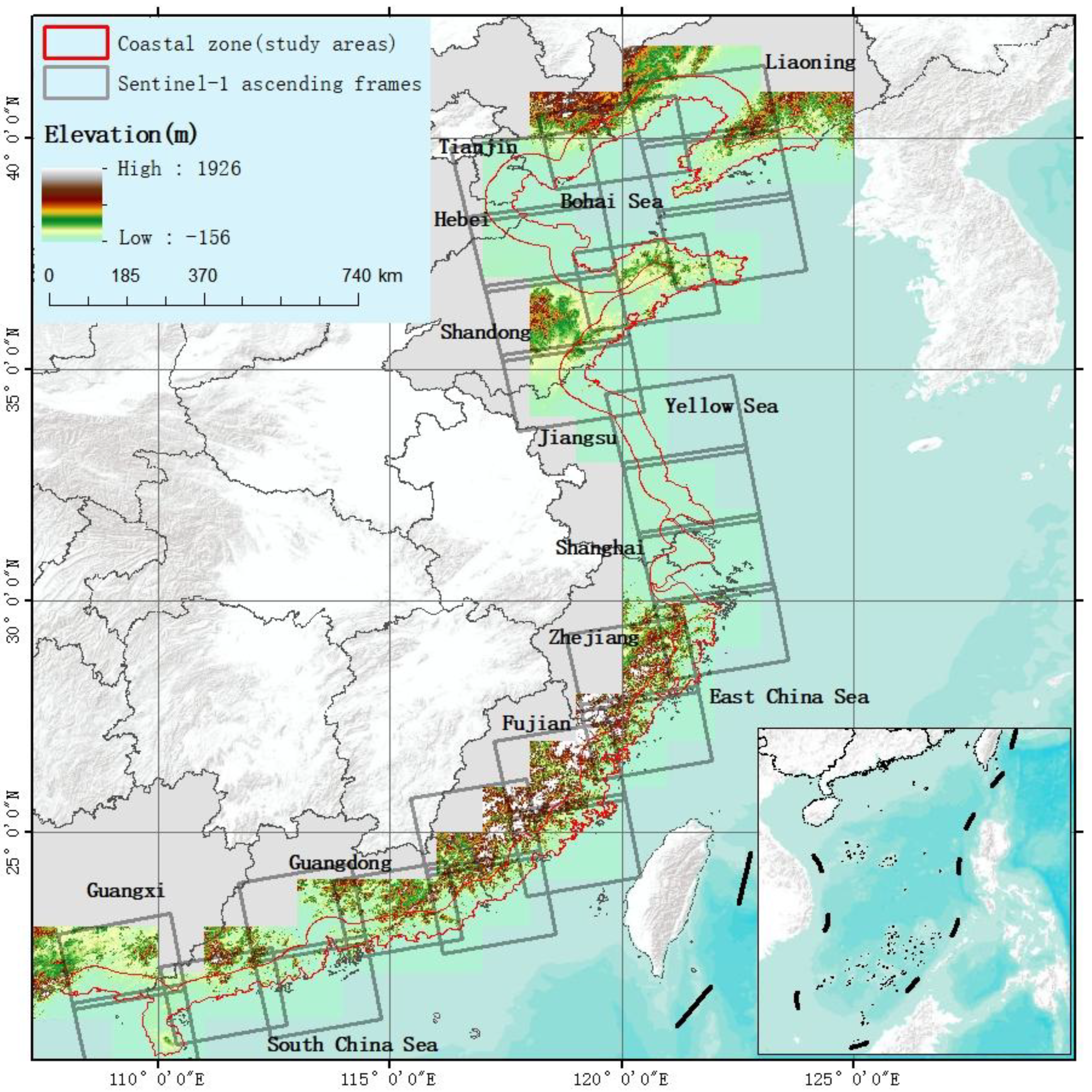
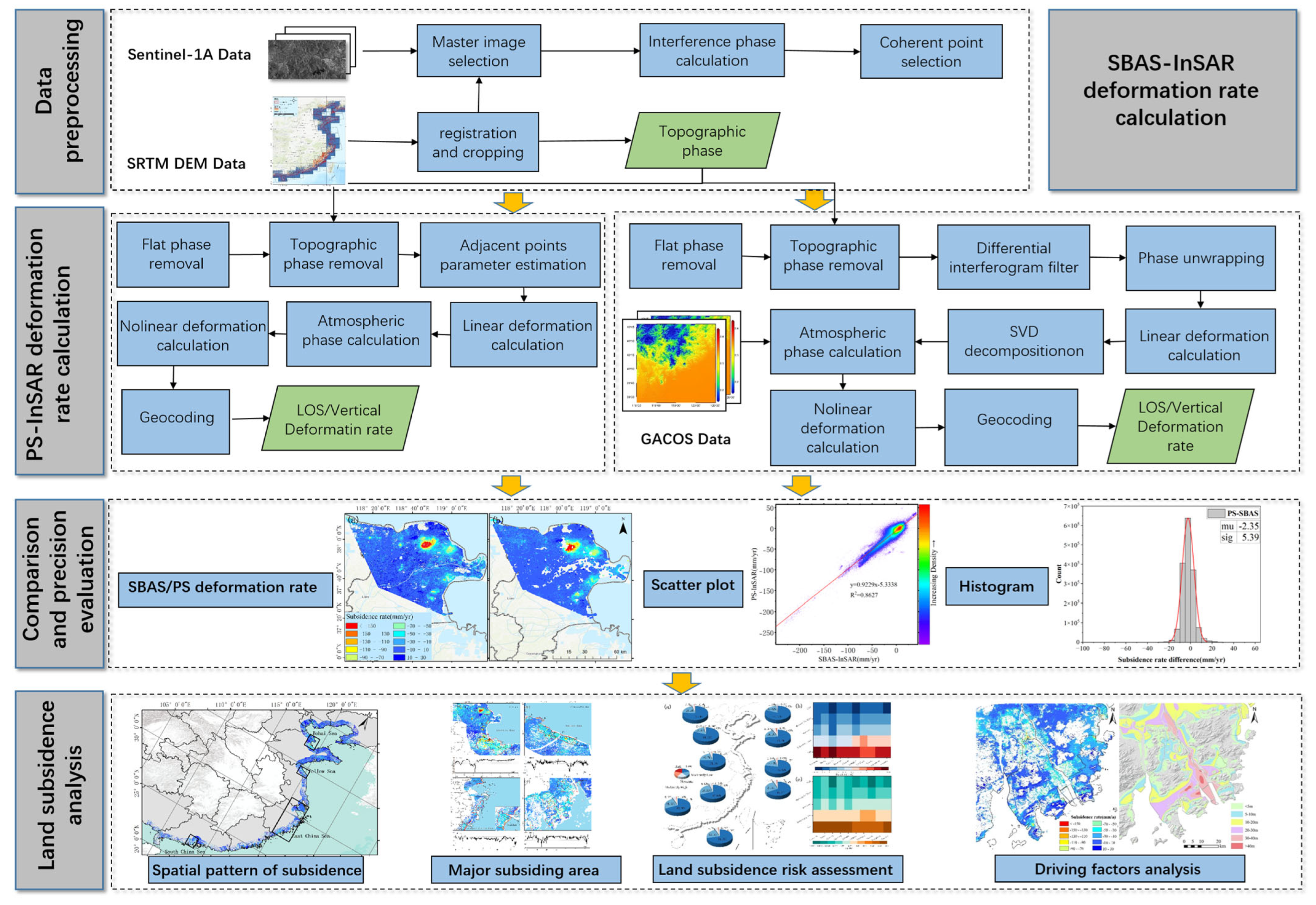
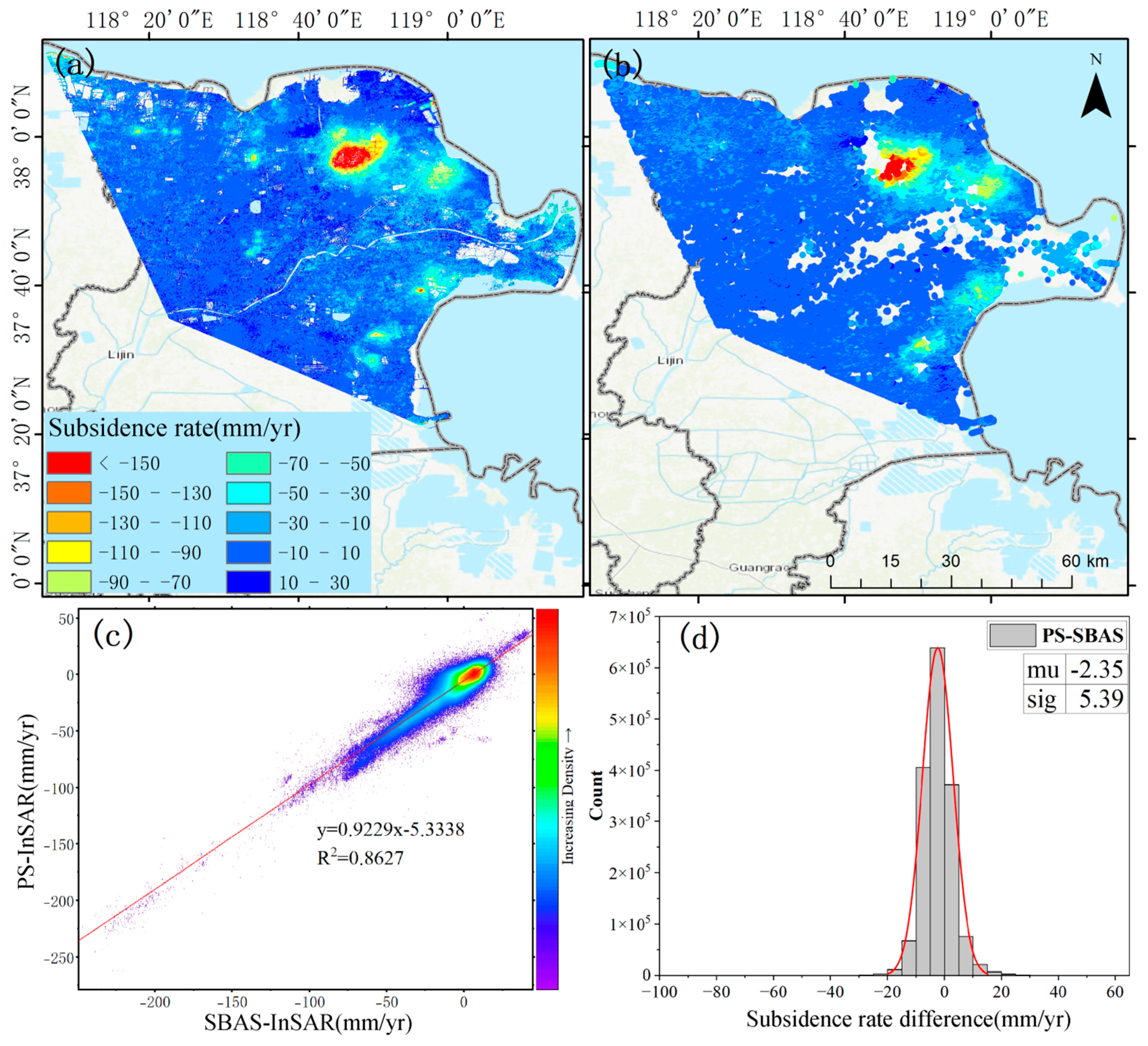
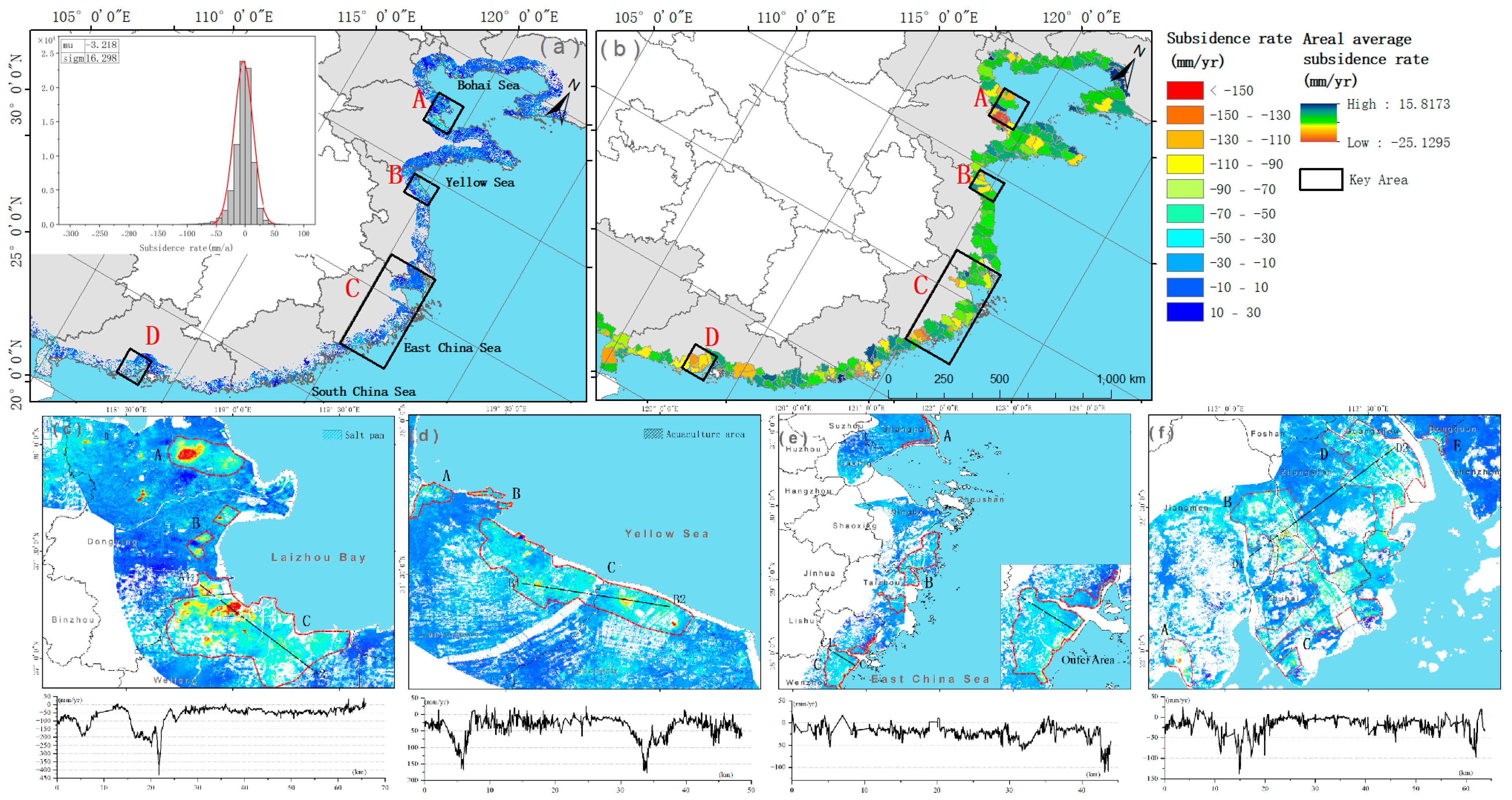
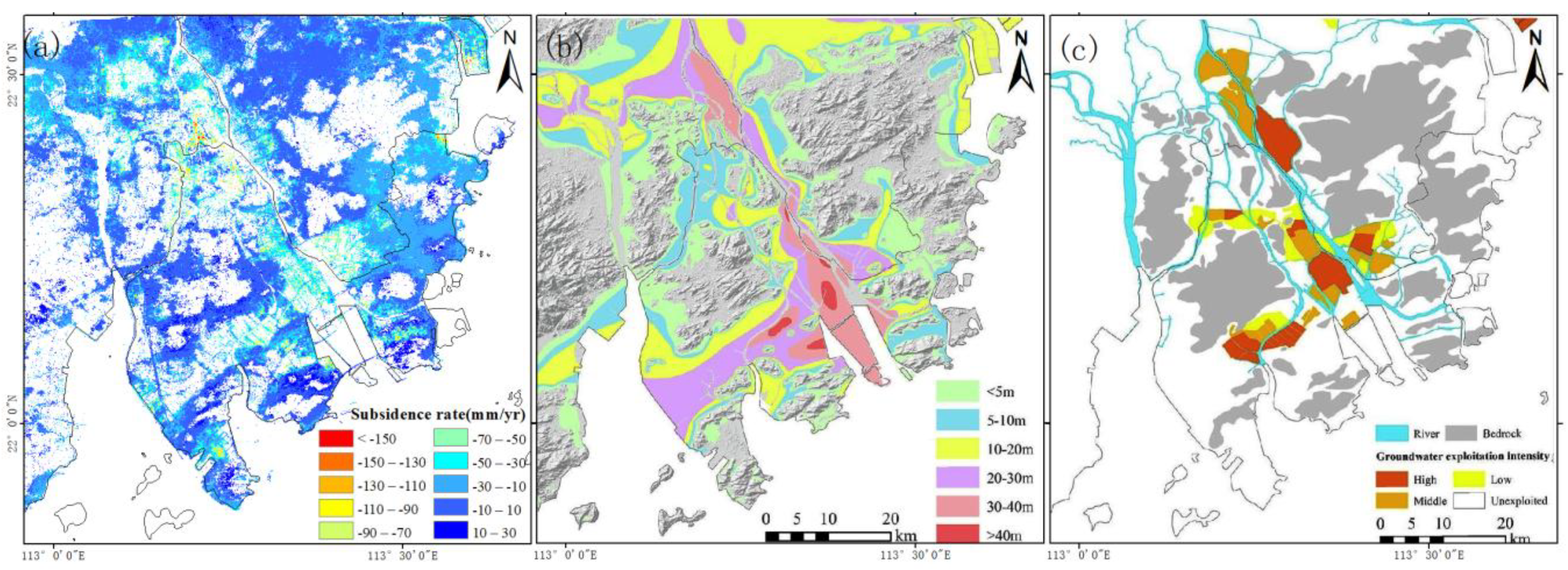
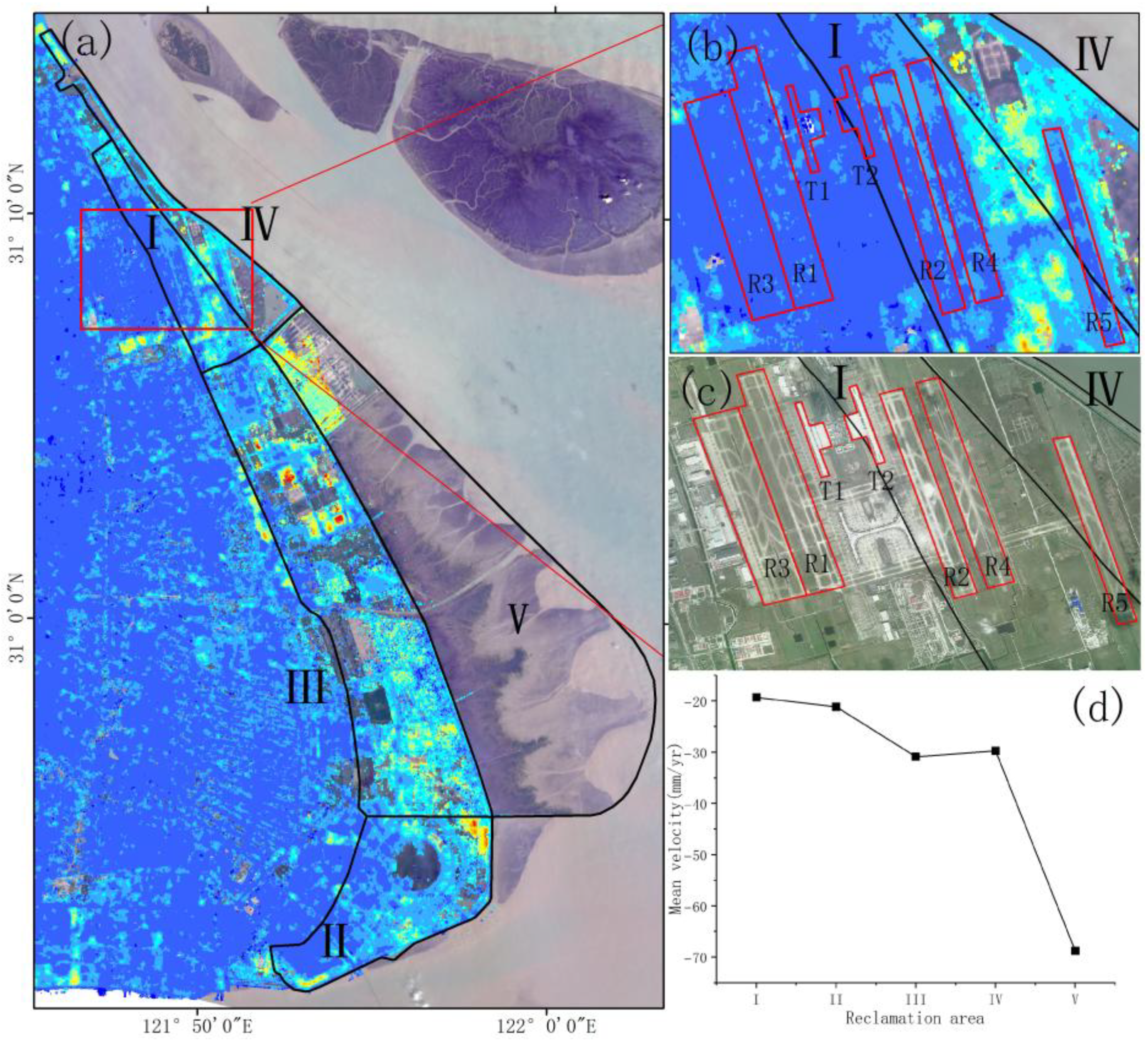

| Parameter | Value |
|---|---|
| Acquisition period | January 2023–December 2023 |
| Number of scenes | 666 |
| Number of frames | 25 |
| Raw data volume | 3.16 TB |
| Band | C |
| Wavelength | 5.6 cm |
| Polarization | VV |
| Spatial resolution (range × azimuth) | 5 m × 20 m |
| Repeat cycle | 12 days |
| Imaging mode | IW |
| Orbit direction | Ascending |
| Swath width | 250 km |
| Reference Path | Adjustment Path-Frame | Mean Offset (mm/yr) |
|---|---|---|
| 69 | 117–126 | −0.87 |
| 171 | 98–129 | 4.54 |
| 69 | 171–116 | −2.20 |
| 171 | 98–119 | −0.53 |
| 69 | 171–106 | −8.87 |
| 171 | 69–89 | 8.75 |
| 69 | 142–81 | −4.74 |
| 142 | 40–77 | −6.50 |
| 40 | 113–71 | 2.05 |
| 113 | 11–71 | 3.89 |
| 11 | 84–65 | −2.71 |
| 84 | 157–62 | 5.32 |
| Key Subsidence Areas | Mean Subsidence Rates | Driving Factors | Cities |
|---|---|---|---|
| Laizhou Bay | −13.31 mm/yr | brine extraction | Dongying, Weifang |
| Northern Jiangsu | −7.35 mm/yr | agricultural-water extraction, soft-soil consolidation | Lianyungang, Yancheng |
| YRD | −5.19 mm/yr | domestic-water extraction, land reclamation | Shanghai, Taizhou, Wenzhou |
| PRD | −9.95 mm/yr | Agricultural and domestic water extraction, soft-soil consolidation, land reclamation, dynamic and static load | Zhuhai, Guangzhou, Zhongshan, Jiangmen |
| Indicator | Low | Moderately Low | Moderate | Moderately High | High |
|---|---|---|---|---|---|
| Subsidence rate (mm/yr) | >−10 | −10~−30 | −30~−50 | −50~−80 | <−80 |
| Risk Level | Subsidence Rate (mm/yr) | Area (km2) | Area Proportion | Population (×104) | GDP (Million CNY) |
|---|---|---|---|---|---|
| Low | >−10 | 153,295.61 | 76.21% | 16,815.59 | 28,284.56 |
| Moderately low | −10~−30 | 37,658.30 | 18.72% | 3109.11 | 5303.81 |
| Moderate | −30~−50 | 7712.00 | 3.83% | 303.42 | 618.23 |
| Moderately high | −50~−80 | 1919.92 | 0.95% | 52.97 | 135.92 |
| High | <−80 | 578.53 | 0.29% | 7.42 | 34.91 |
Disclaimer/Publisher’s Note: The statements, opinions and data contained in all publications are solely those of the individual author(s) and contributor(s) and not of MDPI and/or the editor(s). MDPI and/or the editor(s) disclaim responsibility for any injury to people or property resulting from any ideas, methods, instructions or products referred to in the content. |
© 2025 by the authors. Licensee MDPI, Basel, Switzerland. This article is an open access article distributed under the terms and conditions of the Creative Commons Attribution (CC BY) license (https://creativecommons.org/licenses/by/4.0/).
Share and Cite
Fa, W.; Wang, H.; Liu, W.; Chu, H.; Wu, Y. Subsidence Monitoring and Driving-Factor Analysis of China’s Coastal Belt Based on SBAS-InSAR. Sustainability 2025, 17, 9592. https://doi.org/10.3390/su17219592
Fa W, Wang H, Liu W, Chu H, Wu Y. Subsidence Monitoring and Driving-Factor Analysis of China’s Coastal Belt Based on SBAS-InSAR. Sustainability. 2025; 17(21):9592. https://doi.org/10.3390/su17219592
Chicago/Turabian StyleFa, Wei, Hongsong Wang, Wenliang Liu, Hongxian Chu, and Yuqiang Wu. 2025. "Subsidence Monitoring and Driving-Factor Analysis of China’s Coastal Belt Based on SBAS-InSAR" Sustainability 17, no. 21: 9592. https://doi.org/10.3390/su17219592
APA StyleFa, W., Wang, H., Liu, W., Chu, H., & Wu, Y. (2025). Subsidence Monitoring and Driving-Factor Analysis of China’s Coastal Belt Based on SBAS-InSAR. Sustainability, 17(21), 9592. https://doi.org/10.3390/su17219592






